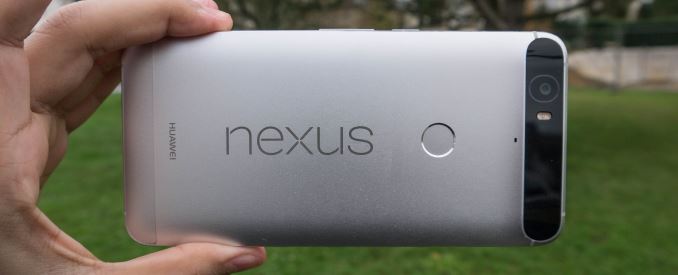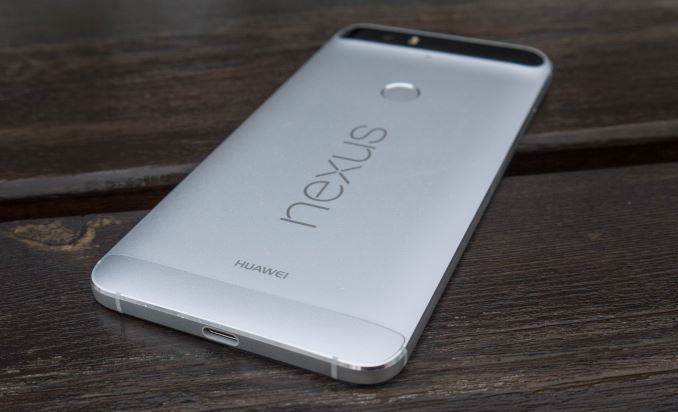The Google Nexus 6P Review
by Andrei Frumusanu on December 16, 2015 8:00 AM ESTFinal Words
As we reach the conclusion of our Nexus 6P review, we’re hopefully left with a more educated view of how the 6P performs and why it perform as it does. It’s also the first showing from Huawei as a Nexus partner, and I think that Huawei has proven itself to be an extremely competent partner at that.
Design-wise, the Nexus 6P takes advantages of Huawei’s experience in building aluminium uni-body phones which results in an extremely solidly built device. While the front face of the phone doesn’t have too much character to it due it being little more than an all-black glass surface with screen and the two speaker grills, it’s the back that makes the Nexus 6P to be instantly recognizable. The “visor” as people have come to call it serves both as an aesthetic feature as well as a practical one as it houses the camera system and flash.
The metal finish and polish makes for a solid grip that is helped by the comparatively flatter sides of the device. Here the 6P trades in a bit of in-hand feel for better handling of the large form-factor. And make no mistake as the Nexus 6P is very much a large form-factor phablet device. The 5.7” screen compares to competing devices such as the Note 5 or the Mi Note Pro, however the 6P is noticeably larger than its cousins due to larger bezels both on the sides and especially on the top and bottom.
The large screen is backed by an excellent AMOLED panel from Samsung. Here Google seems to have made a much better choice in panels than what we saw in last year’s Nexus 6 or what Huawei seems to have employed in their own Mate S. Picture quality is comparable to the Note 5, although the 6P loses out in terms of efficiency, only able to slightly beat the Note 4’s screen efficiency.
Performance wise, the Nexus 6P is excellent. Huawei’s internal design and handling of the SoC’s thermal dissipation makes this the best implementation of Qualcomm’s Snapdragon 810 SoC. CPU performance is currently among one of the best, particularly in bursty workloads, although it can’t really match the sustained and consistent performance of Samsung’s Exynos 7420 devices or even last year’s Snapdragon 801/805 phones. Gaming performs well too, although we again see that sustained performance is only about half of peak performance, an issue competing high-end Android devices also have to deal with.
Battery life, while being subjectively is very good to the point that no user would have to complain about it, it still falls behind the competition. I’ll be honest and say that 2015 has been a pretty bad year for Android devices, as other than Samsung, vendors had to rely on the Snapdragon 810/808’s rather disappointing power efficiency. It’s the fact that you know that a device could have done much better had it had a different SoC that simply leaves me hesitant in praising the Nexus 6P’s battery life. It reminds me of Huawei’s own Mate 7, which while it had excellent battery life due to the very large battery capacity, it failed to be able to provide results worthy able to live up to the specifications.
Meanwhile the camera on the Nexus 6P is among the best, although there were some software processing and consistency issues discovered. Due to these issues encountered in my testing I’m a bit undecided on how to evaluate the 6P’s camera. In situations where it manages to perform, it performs excellently. But as we’ve seen there’s also scenarios where it struggles to get good exposure, and I view that as more important than having an edge in sharpness and effective spacial resolution. And an edge in sharpness is something the Nexus 6P very much has. While the Nexus 6P’s daylight performance can be argued about, it absolutely seems to lead in low-light scenarios as the camera sensor is able to resolve that much more details than the competition; as long as it exposes and color-balances correctly (most of the time).
Wrapping things up, we’re left with the question of the Nexus 6P is a worthwhile buy or not. Here I’d like to offer two conclusions, one for US users and one for buyers in Europe and the rest of the world. At a US price starting at $499 for an unlocked variant, it seems that the Nexus 6P hits a sweet-spot in terms of price-performance and is able to position itself very competitively against other devices. Google’s own services are also much more prevalent and far reaching in North America, so there’s definitely advantage of having a pure Nexus experience (Along with the non-carrier firmware advantage). Here the Nexus 6P is definitely a worthwhile purchase.
For regions outside of North America, and Europe especially, the Nexus 6P just seems an unreasonable device. Starting at prices from 649€, you would expect a device without drawbacks, and it’s simply not worth the premium over other devices, or at the same price you’ll be better off with an equally priced S6 Edge+ or Note 5 if it’s available in your region. Here, the Nexus 6P just simply doesn’t seem that attractive unless you’re putting a lot of weight into the Google Nexus experience, which I find to be a rather subjective aspect of the device. With Snapdragon 820 phones coming in just a few months there’s also the viable option to hold out for better alternatives as we're on the verge of a large generational jump that will undoubtedly bring a lot of improvements to the table.












219 Comments
View All Comments
Andrei Frumusanu - Wednesday, December 16, 2015 - link
You're right, it's just something that I got used to saying after several reviews of Huawei devices lacking the 5GHz band.xenol - Wednesday, December 16, 2015 - link
I'm still not getting why the phone only implements USB 2.0. The only thing I can think of is to save pins and traces from implementing 3.0/3.1 but that just seems silly.twizzlebizzle22 - Wednesday, December 16, 2015 - link
I read a write up on the samsung USB 3.0 implementations. The controller generates a fair amount of heat and could only be used for short periods of time. I'm not sure how far that silicon has come but i'd imagine it's not worth it for most people.I'll try dig the article up.
dcdttu - Wednesday, December 16, 2015 - link
A more opinionated review than I usually expect from Anand, and it seemed to go against most other blog's praise of the device as possibly being the best Android device ever made. Maybe it's the author's dislike of stock Android, also going against the current trend in reviews. Everyone is entitled to their opinion, but I expect such open bias in reviews from the likes of The Verge (who loved it, actually), not Anand.Additionally, the lack of things such as a brightness slider in the notification window is likely for two reasons. One, it's not a notification. Two, it takes valuable real estate away from actual notifications. Samsung's overly-crowded notification center is a perfect example of how not to do it. It's bloated and full of things that aren't notifications at all. Stock Android's implementation is more elegant in my opinion.
mystilleef - Wednesday, December 16, 2015 - link
I'm one of those dudes who call The Verge's review a joke and tell people to wait for the Anandtech reviews, but this one thoroughly left me scratching my head.amdwilliam1985 - Thursday, December 17, 2015 - link
same here, I'm so glad I've bought my Nexus 6P before reading this reviews.BTW, loving my 6P, practically doubled my battery life(coming from Nexus 5). My SoT can easily reach 4 hours(sometimes only 3+ hours), depending on how much of Clash of Clan I play throughout the day :)
tuxRoller - Thursday, December 17, 2015 - link
Your first paragraph excellently summarizes my concerns with this review.hfm - Thursday, December 17, 2015 - link
Wait.. There IS a brightness slider in notification shade, pull it down twice.R. Hunt - Thursday, December 17, 2015 - link
So don't think about it as a notification window. Stock is cleaner, I agree. Samsung is simply way more convenient and useful for me.Breezer23 - Wednesday, December 16, 2015 - link
Man! I see these pictures of the aluminum in the real world and I'm bummed I got graphite.Regardless, good review overall. As the reviewer stated, the location of the [over sensitive] volume rocker and power button is strange. It is my only real compliant with this device.
Coming from the iPhone 6+, the only real things I miss is iMessage features with fellow iPhone owners and battery life. I found the battery life on the iPhone 6+, especially when using it for heavy graphics, to be far superior. I would suspect this is not a problem specific to this phone though.
Speaking of iMessage. Apple really should bring this over to Android with the iPhone specific features and make it ad supported. They'd make a killing!